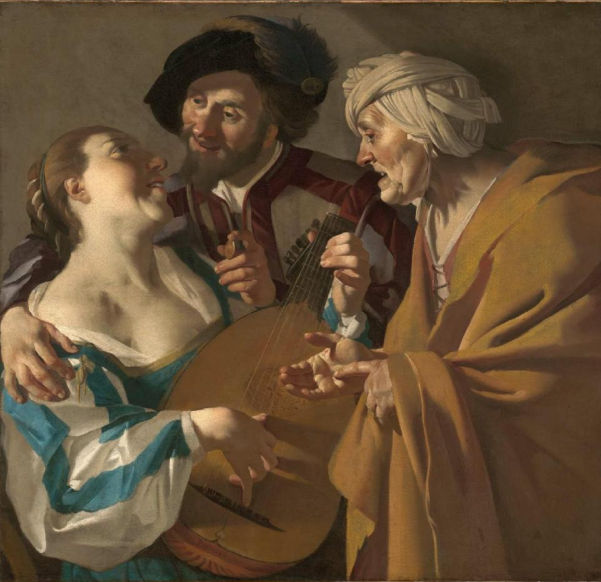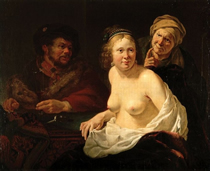The Procuress
1656Oil on canvas
143 x 130 cm. (56 1/8 x 51 1/8 in.)
Gemäldegalerie Alte Meister, Dresden
What made Vermeer abandon his early ambitions?
Clearly, Vermeer initially aspired to make a career as a history painter. However, after The Procuress he never returned to such themes and almost exclusively painted domestic scenes for the rest of his career. He also significantly reduced the dimensions of his paintings, probably to reflect their intimate character and his patrons' expectations, as well as, possibly, the size of their homes. It is telling that his only two forays into allegories—The Art of Painting (fig. 1) and Allegory of the Catholic Faith (fig. 2) —are also the largest of his later oeuvre.

Johannes Vermeer\
c. 1662–1668
Oil on canvas, 120 x 100 cm.
Kunsthistorisches Museum, Vienna

Johannes Vermeer
c. 1670–1674
Oil on canvas, 114.3 x 88.9 cm.
Metropolitan Museum of Art, New York
Firstly, he was not the only one to change his career path. Several contemporaries started as history painters only to become specialists in other fields: the landscape painters Nicolaes Berchem, Aelbert Cuyp and Paulus Potter, as well as the genre painter, Gabriël Metsu. Such shifts were probably always influenced by a variety of factors, from economics to taste and from artistic skills to personal preferences. We have to assume the same for Vermeer’s step around 1656. Shortly after he painted The Procuress, Vermeer’s relationship with the collectors and his possible patrons, Pieter Claesz van Ruijven and his wife, Maria de Knuijt began. Vermeer had met Gerard ter Borch in 1653, who painted tranquil interiors from the early 1650s. Also in Delft, Pieter de Hooch specialized in domestic scenes around 1654–1655. This clearly reflects a demand for genre pieces that probably much exceeded that for large history paintings. Moreover, Vermeer’s increasing interest in light and optics was probably encouraged by a network of like-minded individuals, also in Delft's scholarly and scientific community.
Finally, it has been observed that this shift played to Vermeer’s strength, which "lay more in stillness than in movement," in other words, more in the introvert, serene domestic scenes than the inherently extrovert narratives.
Vermeer’s transition from early to mature works has been described as a gradual development. Indeed, some defining elements of Vermeer’s mature work, namely his interest in the physical and spiritual qualities of light and its effects and the introvert character of his scenes, can be traced in his four early paintings to different degrees. However, Vermeer’s journey of the first three years as a master painter is most remarkable. It was a brief but intense period of trying and searching, leading from depicting a biblical story to a brothel scene. There should be no doubt that around 1656 Vermeer took a fairly radical decision, to abandon history painting and large formats. It is a tempting thought that Vermeer followed not only the market and his own inclination, but ultimately Christ’s message: choosing the contemplative over the active, embarking on a journey of exploring the sacred in the profane.
Few of Vermeer's paintings are as provocative as this fascinating scene of mercenary love, which, in its subject, as well as in its momentary gestures and expressions, seems to differ from his earlier biblical and mythological scenes. Here, behind a balustrade covered by a richly decorated rug, a procuress looks approvingly at a soldier, who offers a young woman a coin while fondling her breast. Holding a glass of wine in one hand, she willingly accepts his proposition with her other.
Vermeer was apparently inspired to paint this subject by Dirck van Baburen's The Procuress (fig. 3), a painting that Maria Thins owned and that Vermeer depicted in two of his works. Nevertheless, Vermeer's painting may have biblical allusions. On the left, an elegant dandy, dressed in a beret and a fashionable slit-sleeve jerkin, smiles out at the viewer as he holds aloft a glass and grasps a musical instrument. This dimly lit figure is probably a self-portrait, with Vermeer assuming the guise of the Prodigal Son, a tale many seventeenth-century artists, including Rembrandt, played in depictions of merry company scenes. This painting is the first instance in which Vermeer strove for a sense of realism through his painting techniques. For example, he used thick impastos to convey the rough texture and three-dimensional character of the ceramic wine pitcher.

Dirk van Baburen
1622
Oil on canvas, 101.6 x 107.6 cm.
Museum of Fine Arts, Boston
We have no record of the conditions in which Vermeer's style was formed. If he served an apprenticeship we do not know of it and there is no reason to think that the eulogy which couples his name with Fabritius means more than it says. It does not seem, although conjecture has been rife, that the obscurity hides any very exotic influence; wherever Vermeer's sources can be traced beyond doubt it is clear that they were common knowledge among the artists of his school. Of Vermeer's links with his contemporaries we have indeed a wealth of evidence throughout his career. When his pictures are examined in their historical context it is seen that they present numerous and close similarities of matter to works by other artists of the time. Here many of Vermeer's interpreters appear to suffer a certain embarrassment. One of them, grappling boldly with the difficulty, suggested that the explanation is simply that Vermeer originated the motifs in question; the great part of his achievement and his widest influence were assigned in consequence to the time of The Procuress and the preceding years. Amateurs of the controversy will notice that the present study agrees with the consensus of recent opinion at least in differing from the views of Dr. Valentiner. If we cannot with reason regard Vermeer as one of the most inventive of Dutch masters it is necessary to examine the alternative and at this point critical logic has hesitated. Yet the issue is relevant to any consideration of the artist's temperament. Investigation must begin with our single piece of direct and undoubted evidence, the date of 1656 home by The Procuress.
Pieter de Hooch
1652
44 cm × 35 cm.
Museum Boijmans Van Beuningen, Rotterdam
Venal love is among the commonest subjects of northern genre painting in its earlier phases, and in particular of the school of Utrecht. Vermeer's rendering differs notably from the sumptuous and lascivious transactions (fig. 4) of his predecessors; the bravo of Utrecht is here exchanged for the humane and domestic characters who people the painting of the school of Delft. These figures and their milieu, transposed into Vermeer's native clarity and dignified beyond measure, are in fact precisely those of Pieter de Hooch's pictures of about three years earlier. One of them, the famous example in the Van Beuningen collection (fig. 5), anticipates something of the counterpoint of Vermeer's arrangement. Nevertheless The Procuress retains a definite flavour of the Caravaggesque, perhaps the clearest appearance of it anywhere in Vermeer's work; the subject, the hint of candle-light which never appears again, and the composition, although there is nothing chaotic or voluminous here, all convey it. Groups of half-length figures arranged behind carpet-covered tables which, seen rather from below, make a sharp horizontal division of the picture, were a common theme of the painters of Utrecht. It is unlikely that Vermeer had far to look for an example. Barent Fabritius, who can hardly have been unknown to him, painted a few months earlier a family portrait (fig. 5) which is precisely similarly planned. Very possibly both compositions descend from a common source.

Barent Fabritius
1656
Oil on canvas, 148 x 128 cm.
Rijksmuseum, Amsterdam
In later pictures Vermeer assimilated the device and put it to his own characteristic use. The obstruction of space held peculiar advantages to the painter's temperament. The roots of this design stretch far beyond its immediate sources; as so often, Vermeer owes his strength to his position at the meeting of several currents. His composition was not only identified with the beginnings of genre painting, it was particularly associated with the theme of venal love (fig. 6). One of the early appearances of the subject in northern art, a broadsheet bearing the monogram of Urs Graf (fig. 7), presents an exact prototype of The Procuress.

Jan van Bronckhorst
Oil on canvas, 91.5 x 114 cm.
Brukenthal National Museum
Sibiu/Hermannstadt, Romania

Urs Graf
With The Procuress, painted in 1656, Vermeer broached a new category that, every since the eighteenth century, has been known as "genre." In fact, The Procuress is only a transitional work in this category: it could just as well have been called "The Story of the Prodigal Son" or "The Prodigal Son among the Whores," valid titles for histories. Vermeer's first true genre picture comes a year or two later with the Girl Asleep at a Table, also known as The Drunken Maid.
Vermeer was surely inspired to paint The Procuress by the presence in Maria Thins's home (which was probably his home by then too) of Dirck van Baburen's Procuress, presumably identical with the "Procuress Pointing in the Hand" described in the inventory drawn up when Catharina's parents separated in 1641. Maria Thins had brought the painting to her house in Delft. Vermeer later included portions of it in two of his works (The Concert, painted about 1664, and the A Lady Seated at a Virginal of 1674–1675). If the subject inspired him, Baburen's mise-en-scène (fig. 3) did not. There is little in common between the two compositions. Vermeer's is vertical in format, Baburen's horizontal. Vermeer has represented four figures against Baburen's three. Baburen, in typical Caravaggist fashion, cuts off his figures at the hip; monumental, they take up nearly the entire picture space. Vermeer's construction of the right side of the picture is actually more reminiscent of Jan Lieven's Fortune Teller (fig. 8), which may have been in his father's (and later in his) possession. About the only direct echo of Baburen's painting in Vermeer's Procuress is the young man's manner of offering a coin to the girl.

Jan Lievens
Oil on canvas 161.2 x 142.3 cm.
Staatliche Museen Preußischer Kulturbesitz, Gemäldegalerie, Berlin
From an aesthetic viewpoint, Vermeer's Procuress is distinguished by its two solid colors-red in the man's jacket, yellow in the courtesan's. These are the colors that one would expect to see, though more muted, in a candlelight scene. The influence of Rembrandt's chiaroscuro seems clearly perceptible, though it may have been filtered through the Amsterdam master's disciples. The idea of using intense colors with little or no local variation in large areas may have come from Rembrandt's pupil Nicholaes Maes. Jacob van Velsen, a Delft painter of an earlier generation, may also be cited here. Van Velsen painted intimate genre scenes (fig. 9) in saturated colors that remind us a little of Vermeer's. A Roman Catholic, he lived until his death in 1656—the year The Procuress was painted—on the Oude Langendijk, a few doors from Maria Thins's house.

Jacob van Velsen
1631
Oil on oak, 40 x 55.8 cm.
National Gallery, London



